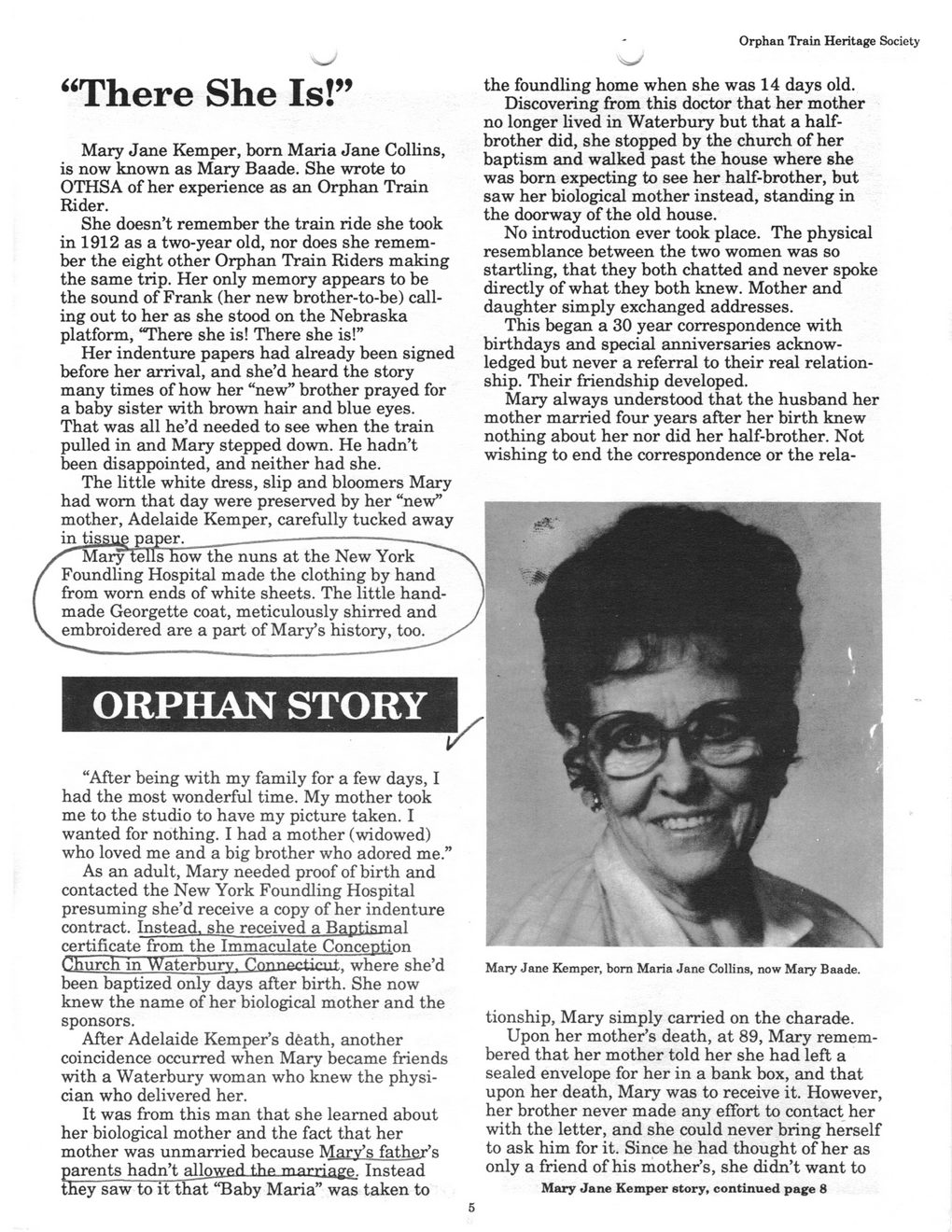This text was obtained via automated optical character recognition.
It has not been edited and may therefore contain several errors.
Orphan Train Heritage Society “There She Is!” Mary Jane Kemper, born Maria Jane Collins, is now known as Mary Baade. She wrote to OTHSA of her experience as an Orphan Train Rider. She doesn’t remember the train ride she took in 1912 as a two-year old, nor does she remember the eight other Orphan Train Riders making the same trip. Her only memory appears to be the sound of Frank (her new brother-to-be) calling out to her as she stood on the Nebraska platform, “There she is! There she is!” Her indenture papers had already been signed before her arrival, and she’d heard the story many times of how her “new” brother prayed for a baby sister with brown hair and blue eyes. That was all he’d needed to see when the train pulled in and Mary stepped down. He hadn’t been disappointed, and neither had she. The little white dress, slip and bloomers Mary had worn that day were preserved by her “new” mother, Adelaide Kemper, carefully tucked away in tissue paper.____________—------------------ lary tells how the nuns at the New York Foundling Hospital made the clothing by hand from worn ends of white sheets. The little handmade Georgette coat, meticulously shirred and embroidered are a part of Mary’s history, too. ORPHAN STORY the foundling home when she was 14 days old. Discovering from this doctor that her mother no longer lived in Waterbury but that a half-brother did, she stopped by the church of her baptism and walked past the house where she was born expecting to see her half-brother, but saw her biological mother instead, standing in the doorway of the old house. No introduction ever took place. The physical resemblance between the two women was so startling, that they both chatted and never spoke directly of what they both knew. Mother and daughter simply exchanged addresses. This began a 30 year correspondence with birthdays and special anniversaries acknowledged but never a referral to their real relationship. Their friendship developed. Mary always understood that the husband her mother married four years after her birth knew nothing about her nor did her half-brother. Not wishing to end the correspondence or the rela- “After being with my family for a few days, I had the most wonderful time. My mother took me to the studio to have my picture taken. I wanted for nothing. I had a mother (widowed) who loved me and a big brother who adored me.” As an adult, Mary needed proof of birth and contacted the New York Foundling Hospital presuming she’d receive a copy of her indenture contract. Instead, she received a Baptismal certificate from the Immaculate Conception Church in Waterbury. whow she’d been baptized only days after birth. She now knew the name of her biological mother and the sponsors. After Adelaide Kemper’s dfeath, another coincidence occurred when Mary became friends with a Waterbury woman who knew the physician who delivered her. It was from this man that she learned about her biological mother and the fact that her mother was unmarried because Mary’s father’s parents hadn’t allowed the marriage Instead they saw to it that “Baby Maria” was taken to Mary Jane Kemper, bom Maria Jane Collins, now Mary Baade. tionship, Mary simply carried on the charade. Upon her mother’s death, at 89, Mary remembered that her mother told her she had left a sealed envelope for her in a bank box, and that upon her death, Mary was to receive it. However, her brother never made any effort to contact her with the letter, and she could never bring herself to ask him for it. Since he had thought of her as only a friend of his mother’s, she didn’t want to Mary Jane Kemper story, continued page 8

Orphan Train Riders of BSL Document (105)